| Pages:
1
..
12
13
14
15
16
..
40 |
Endimion17
International Hazard
    
Posts: 1468
Registered: 17-7-2011
Location: shores of a solar sea
Member Is Offline
Mood: speeding through time at the rate of 1 second per second
|
|
Quote: Originally posted by Dennis SK  | They wasn't cheap thats for sure.
But alkali metals have always been some of my favorite elements. So naturally I looked for the best samples I could possibly find.
It took 5 years and so many inspections of Rb/Cs ampoules.
Trust me, depending on source its relatively easy to find clean samples of Rb/Cs in ampoules below 10 gram. But to find large clean, particle free
samples above 10g of especially Cs... Good luck! 
For info the purity are the following:
Rb, Certified 99,95% minimum. But possibly even more pure.
Cs, Certified 99,99% minumim.
Glad you guys like the pictures. Once I get a better camera I will take high-end pictures.
[Edited on 25-3-2012 by Dennis SK] |
Your camera is perfectly fine. You just need to take an artistic approach. Some black cloth for the background and a diffused light source, together
with photography rules should do the trick. 
|
|
|
Dennis SK
Harmless

Posts: 21
Registered: 12-3-2012
Member Is Offline
Mood: No Mood
|
|
Quote: Originally posted by Endimion17  |
Your camera is perfectly fine. You just need to take an artistic approach. Some black cloth for the background and a diffused light source, together
with photography rules should do the trick.  |
That "Camera" is actually a mobile phone camera 
I didnt think much of artistics when I took the pictures. I just melted the Rb/Cs, thought it looked really nice and tried to catch it.
I have a friend who work as photographer. He has a "photo box" or a "light diffuser box" I think its called. He will help me take very good pictures.
Those pictures will also be used instead of some of my current wikipedia pictures.
Really looking forward to show even better pictures of completely oxide free Rb/Cs. Of course, one can only see the true beauty "In real life"
|
|
|
dann2
International Hazard
    
Posts: 1523
Registered: 31-1-2007
Member Is Offline
Mood: No Mood
|
|
There are some mighty pretty pictures here.
Two Sodium Perchlorate shards.
They are the same shard. One was photographed with a polarizing filter on camera.
What colour is Cobalt Perchlorate anyone know?
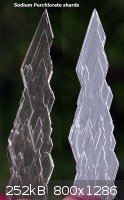
[Edited on 29-3-2012 by dann2]
Attachment: shards in cell.zip (337kB)
This file has been downloaded 434 times
|
|
|
barley81
Hazard to Others
  
Posts: 481
Registered: 9-5-2011
Member Is Offline
Mood: No Mood
|
|
Most cobalt (II) salts are red-purplish. Cobalt (II) perchlorate is likely to be similar in color to the nitrate or sulfate.
Such a large shard of a single salt! Isn't it really fragile? How did you make a crystal like that?
|
|
|
dann2
International Hazard
    
Posts: 1523
Registered: 31-1-2007
Member Is Offline
Mood: No Mood
|
|
A saturated solution (3.8 liters) of Sodium Perchlorate was cooled from 50°C to around 10°C and lots of shards formed (see zip
attached to last post).
The shards are perhaps two mm thick and not that delicate. If you were to let them fall on a hard surface they would break.
There are more shards in the thread "More on PbO2 Anodes" stuck to an LD Anode.
I have some Barium Perchlorate and Cobalt Sulphate. I might try making some Cobalt Perchlorate by adding the the two together. Ba Sulphate will ppt as
it is insoluble leaving me with a solution of Co Perchlorate.
Dann2
|
|
|
ItalianChemist
Hazard to Others
  
Posts: 172
Registered: 26-1-2011
Location: Italy
Member Is Offline
Mood: No Mood
|
|
Chemiluminescence of Ru(bipy)3(BF4)2
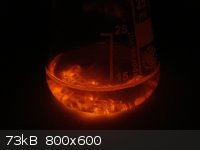
|
|
|
Satan
Hazard to Others
  
Posts: 126
Registered: 1-5-2009
Member Is Offline
Mood: No Mood
|
|
Did you make a OLED with this complex?
|
|
|
White Yeti
National Hazard
   
Posts: 816
Registered: 20-7-2011
Location: Asperger's spectrum
Member Is Offline
Mood: delocalized
|
|
@ItalianChemist, that picture is impressive! How did you take it? I avoid taking pictures of things in the dark because they always come out awful.
That picture might even be good enough for a screen saver considering the size and quality.
"Ja, Kalzium, das ist alles!" -Otto Loewi
|
|
|
Eddygp
National Hazard
   
Posts: 858
Registered: 31-3-2012
Location: University of York, UK
Member Is Offline
Mood: Organometallic
|
|
Just have been looking at those GIANT and INCREDIBLE samples of Cs and Rb and... I took a look at my homemade sodium silicate 'crystals', and left the
camera.
|
|
|
ItalianChemist
Hazard to Others
  
Posts: 172
Registered: 26-1-2011
Location: Italy
Member Is Offline
Mood: No Mood
|
|
Quote: Originally posted by White Yeti  | | @ItalianChemist, that picture is impressive! How did you take it? I avoid taking pictures of things in the dark because they always come out awful.
That picture might even be good enough for a screen saver considering the size and quality. |
Thank you!
I used a normal camera with macro function!
@Satan I haven't done OLED yet!
[Edited on 2-4-2012 by ItalianChemist]
|
|
|
ItalianChemist
Hazard to Others
  
Posts: 172
Registered: 26-1-2011
Location: Italy
Member Is Offline
Mood: No Mood
|
|
Other pictures 
1. Europium nitrate hydrate under UV-A light!
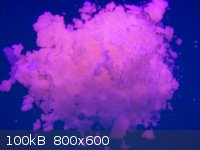
2.Ru(bipy)3(BF4)2 under UV-A light!
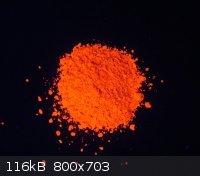
3.Melted iodine
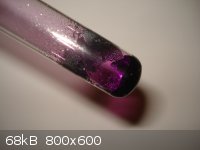
|
|
|
kristofvagyok
National Hazard
   
Posts: 659
Registered: 6-4-2012
Location: Europe
Member Is Offline
Mood: No Mood
|
|
Hi everyone,
This is my first post on the board so let's start it: I work in an organic chemistry lab somewhere in Europe and I am also a freelance photographer so
I got some pictures...
They are not special, no Europium, Ruthenium or any special. just simple organic and inorganic chemistry, but I hope You like them:
More pictures here: http://labphoto.tumblr.com/
-Kristof
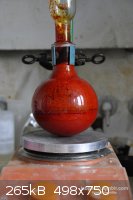 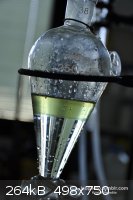 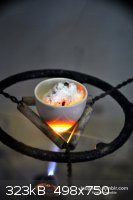
|
|
|
White Yeti
National Hazard
   
Posts: 816
Registered: 20-7-2011
Location: Asperger's spectrum
Member Is Offline
Mood: delocalized
|
|
Hey Kristof.
Nice pictures! They're quite stunning, what kind of camera did you use? Mind if I ask what these pictures are of?
Welcome to the forum!
"Ja, Kalzium, das ist alles!" -Otto Loewi
|
|
|
kristofvagyok
National Hazard
   
Posts: 659
Registered: 6-4-2012
Location: Europe
Member Is Offline
Mood: No Mood
|
|
I use Nikon D5000 with wide variety of lenses.
The pictures are from my current research, what is about nitrogen containing heterocyclic ring formations... And some else thing, what I do in the lab
(last picture is inorganic chemistry).
That cute red thing in the breaker (what is an awesome dye and impossible to remove from your skin ) was a nitro-phenylpyvuric acid ester synthesis from nitrotoluene, dialkly oxalate and some sodium alkoxyde. When this
material contacts any base it turns blood red, otherwise it is yellow. ) was a nitro-phenylpyvuric acid ester synthesis from nitrotoluene, dialkly oxalate and some sodium alkoxyde. When this
material contacts any base it turns blood red, otherwise it is yellow.
The separating funnel contained some ether and some phenylpyvuric acid in the water what didn't reacted in an other kind of reaction.
And the last picture is molten silver under some borax with a methane/oxygen torch.
On the blog there is a lot other picture (updating daily, or as often as I could ) )
[Edited on 6-4-2012 by kristofvagyok]
|
|
|
Adas
National Hazard
   
Posts: 711
Registered: 21-9-2011
Location: Slovakia
Member Is Offline
Mood: Sensitive to shock and friction
|
|
That methane/oxygen torch is just amazing! The temperature must be extremely high!
Rest In Pieces!
|
|
|
Bot0nist
International Hazard
    
Posts: 1559
Registered: 15-2-2011
Location: Right behind you.
Member Is Offline
Mood: Streching my cotyledons.
|
|
Very nice kristofvagyok! Welcome to SciMad. Those pictures are beautiful. Glad your here.
U.T.F.S.E. and learn the joys of autodidacticism!
Don't judge each day only by the harvest you reap, but also by the seeds you sow.
|
|
|
Mailinmypocket
International Hazard
    
Posts: 1351
Registered: 12-5-2011
Member Is Offline
Mood: No Mood
|
|
Finally did the Belousov-Zhabotinsky reaction in a petri dish  too many time
lapse pictures to attach, but amazing to watch happen... hypnotizing! It repeated itself, sort of like a beating heart with the same recurring
pattern. If i swirled the dish new patterns appeared and started the same sequence. Eventually it slowed down and became clear ~15 mins too many time
lapse pictures to attach, but amazing to watch happen... hypnotizing! It repeated itself, sort of like a beating heart with the same recurring
pattern. If i swirled the dish new patterns appeared and started the same sequence. Eventually it slowed down and became clear ~15 mins
The ferroin solution used was prepared by the reaction of 1,10- phenathroline hydrate (0.88g) and ferrous sulfate (0.35g) in 50 ml distilled H2O.
*Edit* The pictures were attached in reverse order, it goes red to blue.
See section 5.2.3 for procedure here
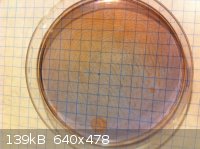 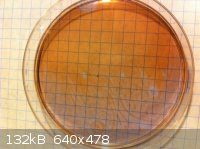 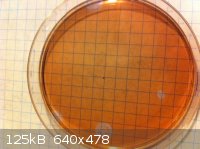
[Edited on 10-4-2012 by Mailinmypocket]
|
|
|
White Yeti
National Hazard
   
Posts: 816
Registered: 20-7-2011
Location: Asperger's spectrum
Member Is Offline
Mood: delocalized
|
|
Those are quite nice! For everyone's viewing pleasure, I'll attach a video of the process (not mine).
<iframe sandbox width="560" height="315" src="http://www.youtube.com/embed/3JAqrRnKFHo" frameborder="0" allowfullscreen></iframe>
"Ja, Kalzium, das ist alles!" -Otto Loewi
|
|
|
Mailinmypocket
International Hazard
    
Posts: 1351
Registered: 12-5-2011
Member Is Offline
Mood: No Mood
|
|
Thanks! That was my first try, Ive seen that video many times too while trying to figure out the ideal mix. Maybe more concentrated ferroin and/or a
catalyst... I didn't add any Ce or Mn, time to tweak the formula! I am going to try with a methyl orange formulation... Hopefully it is as good if not
better
[Edited on 10-4-2012 by Mailinmypocket]
|
|
|
inspector071
Hazard to Self
 
Posts: 69
Registered: 20-2-2012
Member Is Offline
Mood: No Mood
|
|
I've been synthesizing some energetics recently, and in particular, working with recrystallization for stability. It's given me an opportunity to drag
out the microscope and check out some crystals.
Here are some crystals of picric acid recrystallized from boiling water at 100x magnification.
These are quite flat crystals of ETN, recrystallized from methanol, also at 100x magnification. This is what the batch of ETN looks like.
This is a crystal of RDX, created via the direct nitration of hexamine from pure nitric acid, and recrystallized from acetone, yet again at 100x
magnification. The crystals are a bit bigger than table sugar.
|
|
|
Endimion17
International Hazard
    
Posts: 1468
Registered: 17-7-2011
Location: shores of a solar sea
Member Is Offline
Mood: speeding through time at the rate of 1 second per second
|
|
kristofvagyok, those photos are amazing. It really is great what proper lightning, a sense of perspective from a photographer's eye and macro focusing
can do with something that seems so usual.
I was browsing through your tumblr page and noticed you described bromine as having a really bad smell. Why is that?
|
|
|
DJF90
International Hazard
    
Posts: 2266
Registered: 15-12-2007
Location: At the bench
Member Is Offline
Mood: No Mood
|
|
Because it does. Bromine comes from the greek Bromos, which means stench. At least if I remember correctly.
|
|
|
White Yeti
National Hazard
   
Posts: 816
Registered: 20-7-2011
Location: Asperger's spectrum
Member Is Offline
Mood: delocalized
|
|
Isn't bromine a halogen? A volatile one too... Not only do halogens have a smell, but they also destroy your mucous membranes. That's why bromine is
usually chilled before use and handled with utmost precaution.
"Ja, Kalzium, das ist alles!" -Otto Loewi
|
|
|
mr.crow
National Hazard
   
Posts: 884
Registered: 9-9-2009
Location: Canada
Member Is Offline
Mood: 0xFF
|
|
Quote: Originally posted by kristofvagyok  | Hi everyone,
This is my first post on the board so let's start it: I work in an organic chemistry lab somewhere in Europe and I am also a freelance photographer so
I got some pictures...
They are not special, no Europium, Ruthenium or any special. just simple organic and inorganic chemistry, but I hope You like them:
More pictures here: http://labphoto.tumblr.com/
-Kristof
|
Incredible!!
1 L of bromine, that thing is going to weigh 3 kg! I have always wanted to hold that much Br to feel the weight. Its also going to destroy the bottle
cap in no time.
Whats behind the bromine? also looks dangerous
Double, double toil and trouble; Fire burn, and caldron bubble
|
|
|
kristofvagyok
National Hazard
   
Posts: 659
Registered: 6-4-2012
Location: Europe
Member Is Offline
Mood: No Mood
|
|
Quote: Originally posted by mr.crow  |
Incredible!!
1 L of bromine, that thing is going to weigh 3 kg! I have always wanted to hold that much Br to feel the weight. Its also going to destroy the bottle
cap in no time.
Whats behind the bromine? also looks dangerous |
The main problem with the bromine is to pour it out from the bottle and weight it, because of the fumes what comes out from it, smells really bad and
causes not so good things. The positive thing is the fume hood helps a lot(:
This amount of bromine was used to make dimethoxy alkyls from alkenes by one of my friends.
The scheme was like this: RHC=CHR + Br2 = RHBrC-CBrHR
RHBrC-CBrHR + 2R'OH = RH(OR')C-C(OR')HR + 2HBr
Easy reaction with high yields even in this amounts.
And the cap of the bromine is coated with teflon, so it wont be damaged, I hope(:
[Edited on 10-4-2012 by kristofvagyok]
I have a blog where I post my pictures from my work: http://labphoto.tumblr.com/
-Pictures from chemistry, check it out(:
"You can’t become a chemist and expect to live forever." |
|
|
| Pages:
1
..
12
13
14
15
16
..
40 |